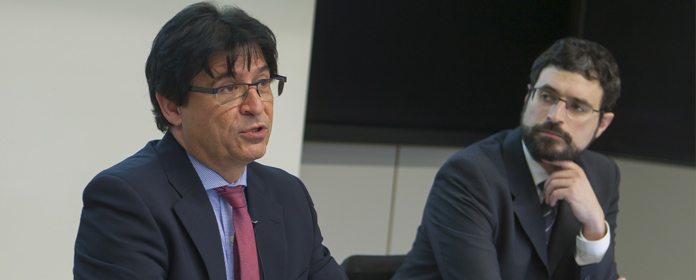14_03_2018_noticia_EyP_juego-infantil
Researchers of the Childhood Play Observatory present 24 indicators in favor of the right to play
The report by researchers Jaume Bantulà and Andrés Payá was presented to the students of the School of Education and Psychology.

With the goal to make students reflect and exchange perceptions, Jaume Bantulà, researcher Principal of project and professor at the Universitat Ramon Llull and Andrés Payá, researcher and professor at the University of Valencia, presented the results of report "Sistema de Indicadores de assessment del Derecho al juego" to the students of the School of Education and Psychology of the University of Navarra, in a session moderated by the Dean of the School, Concepción Naval.
The research, developed by the Observatorio del Juego Infantil at partnership with the Ministry of Economics and Competitiveness, has carried out a system of indicators to measure the implementation of the right to play. "It is not a right that should be taken care of when other children's rights have been achieved", reminded the main researcher , Jaume Bantulà, who denounced its scarce attention in the public and political sphere, despite being the most ratified right in history, included in article 31 of the Convention on the Rights of the Child (CRC).
The researcher Andrés Payá, presented the 24 indicators as result, among others, from the analysis of reports from more than 80 countries sent to committee of the Rights of the Child, as well as from several focus groups and evaluations of experts from the world of childhood and play. The indicators, which target society, school and family, will be fed through the data recorded by the commission of rights violations, socio-economic and administrative statistics, perception surveys and data based on expert judgments. "We have tried to develop a tool to assess the state of health of the child's right to play" highlighted Payá who through this new matrix will try to "observe the current status and trends of change" regarding the fulfillment of the child's right to play in a particular country. In addition, these indicators will also allow them to "evaluate play programs and policies and determine their impact".
Play time, spaces and materials for this activity and the company with which it is carried out, are some of the attributes of the right to play that the researchers presented as a conclusion of the research. They also highlighted some good practices in other countries, such as the Irish initiative on play: READY, STEADY, PLAY, which as a national policy plan has led to the emergence of other local initiatives for the promotion of this right of children.

